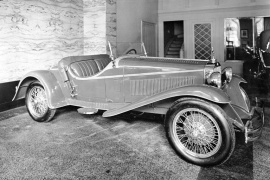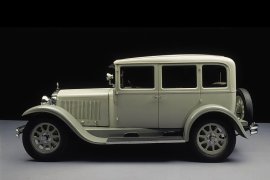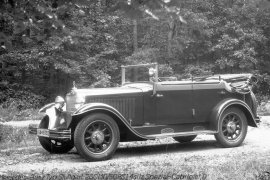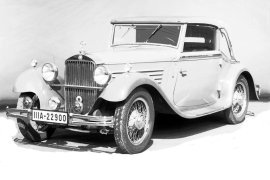MERCEDES BENZ Typ Stuttgart Models/Series Timeline, Specifications & Photos
First production year: 1929
Engines: Gasoline
Following the merger between Daimler-Motoren-Gesellschaft and Benz&Cie, the new board faced a dilemma if they should build expensive or affordable cars, and the board went for the latter.
One of the first products produced by the newly formed company was the Typ Stuttgart lineup, which consisted of different types of vehicles, all based on the same chassis. Since the decision was to create expensive automobiles, a sports car was a must.
The Typ 260 Sportwagen was based on the short wheelbase version of the W11's chassis. Its look was different than on its sibling, sporting a roadster bodywork with a long hood, cut-out doors, and a short rear end. Like other Mercedes-Benz cars from that era, the 260 Sportwagen featured a front fascia with a retracted radiator behind the chassis' ends and a horizontal chromed bar that supported the headlights.
In the cockpit, the carmaker installed a pair of bucket seats designed mostly for comfort, albeit the driving position was quite low, typical for a sports car. After all, the same carmaker already had produced the SSK years before, and it knew how to build a proper sports car. A retractable canvas roof was available, but since there were no side windows, it served mostly for sun protection and less for rain.
Under the long hood, Mercedes-Benz installed the same 2.6-liter inline-six with side valves that produced a healthy 50 horsepower. The powerplant was paired with a three-speed manual gearbox and sent its twisting force to the rear wheels.
After Daimler-Motoren-Gesellschaft and Benz&Cie merged, the board had to decide if they should build luxury cars or just popular vehicles like everybody else.
Daimler noticed that there were just a few luxury German carmakers, especially the Maybach, and insisted on building vehicles for the upper segment, while Benz&Cie considered that there was no market for luxury vehicles. In the end, the two sides took a wise decision: on the same chassis, they built vehicles for the masses, the Typ 200, and for the upper segment as the Typ 260. It was like they did the base model and the full-option version long before other carmakers.
The closed version of the Typ 260 was built as a complete vehicle with the same distinct elements from Mercedes-Benz. It featured the flat vertical radiator with raised top and the three-pointed-star badge mounted on the radiator's cap. A straight bar supported the two electric headlamps placed between the front fenders. Soon the DMG proved that its decision was better, and the 200 model was dropped. The 260 version sales exceeded more than 50 percent of the 200 version.
But DMG didn't just place a bigger engine inside the car and sold it much more expensive. It finished the cabin with large, comfortable, leather upholstered seats and wood veneers on the door panels. Its dashboard, even though it was based on the same panel as the 200, featured better-looking finishes and materials.
Under the hood, the Typ 260 featured a 2.6-liter, inline-six engine, which ran smoother than the one fitted in the Typ 200. Even though it provided only two more ponies, it was much more appreciated by the customers.
When Daimler-Motoren-Gesellschaft and Benz&Cie merged, the new company faced a serious dilemma: either build expensive, luxury cars or mass-market, affordable ones.
The decision was difficult, but in the end, the newly formed Mercedes-Benz focused on the luxury market, and that was a wise decision. Soon after, the automaker introduced the Typ 260, also known as Stuttgart, in a few bodywork versions, including a closed bodywork, a roadster, and a four-door cabriolet known as Cabriolet D.
Changing the bodywork for a car in those times was easy since most vehicles were built on top of a chassis. Thus, Mercedes-Benz didn't have any problems creating a Cabriolet on the same base as the Sedan version. All it had to do was to remove the upper side of the bodywork and install a retractable canvas at the back of the cabin. The vehicle's front looked identical to the Sedan, but there were no B- or C-pillars. Fortunately, the automaker kept the side windows, albeit these were removable for a complete, open-top experience.
To access the cabin, the automaker installed four doors, those at the front being rear-hinged type. There were two seats at the front and a bench in the rear. Mercedes-Benz also focused on using high-quality materials inside to create a luxurious cockpit.
Under the long hood, Mercedes-Benz installed the same 2.6-liter inline-six with side valves that produced a healthy 50 horsepower. The powerplant was paired with a three-speed manual gearbox and sent its twisting force to the rear wheels.
MERCEDES BENZ Typ Stuttgart 260 Spezial Cabriolet D (W11) 2.6
Following the merger between Daimler-Motoren-Gesellschaft and Benz&Cie. , the new management faced the task of creating a standardized and modernized product range.
The two companies had different opinions about the direction the company should go. While the DMG went for the luxury market, the Benz&Cie tried to go to popular products. In 1924, after different debates, the larger supercharged engines were dropped in favor of an inline six-cylinder with a two-liter displacement. The initial target-price was reduced several times until it became less than half of the initial RM 15.000. After the management reached a conclusion, there were two lines produced: the Stuttgart 200 with a 2.0-liter engine and the Stuttgart 260 with a 2.6-liter displacement, which was placed upper on the scale.
The Stuttgart 260 was available in the same range of variants as the two-liter model. The "standard" version of the higher-displacement model was additionally equipped with the honeycomb radiator, the two-seater sports car being available only in the basic version. At the end of 1929, it was obvious that the 260 model, even if it was more expensive, had a better success on the market with 3640 vehicles sold considerably more than 2000 units of the Stuttgart 200.
The Convertible A featured a bigger trunk in the back. It was available with two or four seats. The car was designed to feature a swing axle in the rear, but due to cost-cutting requirements, the series model featured the same solid axle in the back. The leaf-spring suspension was carried over from the tourer version.



